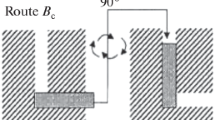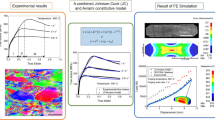Abstract
Deformation during conventional (nonisothermal) hot working of metals via equal-channel angular extrusion (ECAE) was investigated using two-dimensional (2-D) and three-dimensional (3-D) finite-element modeling (FEM) analysis. The effects of material flow properties, die-workpiece heat-transfer and friction conditions, and die design on metal flow were examined. Friction and die design were shown to be the most important parameters governing the formation of dead-metal zones during extrusion. On the other hand, thermal gradients induced by die chill and deformation heating were found to exacerbate the extent of flow localization that arises due to material-flow softening alone. The FEM predictions were validated by ECAE experiments on a Ti-6Al-4V alloy with a colony alpha microstructure. Preforms exhibited minor edge cracking and mild flow localization during extrusion at 985 °C, but severe shear localization and fracture during extrusion at 900 °C. The 2-D FEM simulations predicted deformation detail, including shear localization, that was in good agreement with the experimental results, but 3-D FEM simulations were required to realistically predict die chill. A combined approach, in which thermal data were extracted from 3-D simulations and inserted into 2-D simulations, produced load-stroke and fracture predictions in general agreement with measured values.
Similar content being viewed by others
References
V.M. Segal, V.I. Reznikov, A.E. Drobyshevkiy, and V.I. Kopylov: Russ. Metall., 1981, vol. 1, pp. 99–105.
V.M. Segal: Proc. 5th Int. Aluminum Technology Seminar, 1992, vol. 2, pp. 403–07.
Y. Iwahashi, J. Wang, Z. Horita, M. Nemoto, and T.G. Langdon: Scripta Mater., 1996, vol. 35, pp. 143–47.
S.L. Semiatin, V.M. Segal, R.L. Goetz, R.E. Goforth, and T. Hartwig: Scripta Mater., 1995, vol. 33, pp. 535–40.
V.M. Segal, R.E. Goforth, and K.T. Hartwig: U.S. Patent No. 5,400,633, 1995.
DEFORM System User’s Manual, Version 3.0, Scientific Forming Technologies Corporation, Columbus, OH, 1992.
S.L. Semiatin, E.W. Collings, V.E. Wood, and T. Altan: J. Eng. Industry, 1987, vol. 109, pp. 49–57.
HOTCOMP 2.0, UES Inc., Dayton, OH, 1996.
S.L. Semiatin and J.J. Jonas: Formability and Workability of Metals, ASM, Metals Park, OH, 1984.
J.J. Jonas, R.A. Holt, and C.E. Coleman: Acta Metall., 1976, vol. 24, pp. 911–18.
S.L. Semiatin, V.M. Segal, R.E. Goforth, N.D. Frey, and D.P. DeLo: Air Force Research Laboratory, Wright-Patterson AFB, OH, unpublished research, 1998.
P.R. Burte, S.L. Semiatin, and T. Altan: 1990 Trans. NAMRI/SME, 1990, pp. 59–66.
M.G. Cockcroft and D.J. Latham: NEL Report No. 240, National Engineering Laboratory, Glasgow, Scotland, 1966.
S.L. Semiatin, V. Seetharaman, A.K. Ghosh, E.B. Shell, M. Simon, and P.N. Fagan: Air Force Research Laboratory, Wright-Patterson AFB, OH, unpublished research, 1998.
Author information
Authors and Affiliations
Rights and permissions
About this article
Cite this article
DeLo, D.P., Semiatin, S.L. Finite-element modeling of nonisothermal equal-channel angular extrusion. Metall Mater Trans A 30, 1391–1402 (1999). https://doi.org/10.1007/s11661-999-0287-2
Received:
Issue Date:
DOI: https://doi.org/10.1007/s11661-999-0287-2




